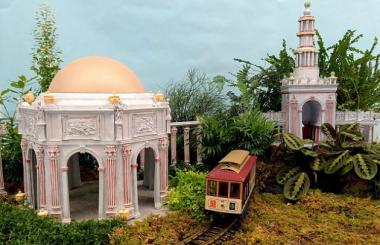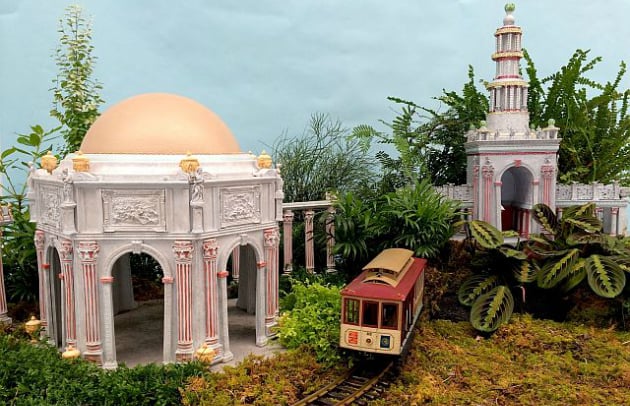
Flowers for a Farewell to the Centennial
As 2015 is winding down, the many centennial celebrations of the 1915 Panama-Pacific International Exposition (PPIE), San Francisco's acclaimed world's fair marking the city's recovery from the Great Quake of 1906, also are receding into past. Among the few reminders is the Conservatory of Flowers’ garden railway exhibition, which runs through April 10.
In the midst of hundreds of dwarf plants, model trains wend their way through the festive fairgrounds, zipping past whimsical recreations of the fair's most dazzling monuments and amusements. Interpretive signs, memorabilia, and interactive activities throughout the show help visitors to understand the colorful history of the grand fair.
G-gauge model trains and streetcars loop around an illuminated miniature of the 43-story Tower of Jewels, which held more than 100,000 pieces of multicolored cut glass and gleamed night and day. The Palace of Horticulture, managed by the renowned horticulturist Luther Burbank, had a glass dome larger than Saint Peter’s Basilica in Rome. The Palace of Fine Arts, surviving to this day, held a juried exhibition described as the nation’s best modern art collection. Also included is a diorama created to reflect the PPIE’s many exhibition halls where 31 nations and many U.S. states touted their most significant resources, such as Iowa’s 27-foot tall Tower of Corn display.
The Joy Zone was the wildly popular amusement area of the fair, filled with rides, concessions, exotic foods, and more, and several of its fantastical attractions are represented in Garden Railway including much smaller versions of the giant-scale replica of the Grand Canyon and the five-acre working model of the Panama Canal that wowed fairgoers. A huge, fake iceberg and shipwreck chronicled the explorer Robert Falcon Scott's doomed polar expeditions. Overhead, model airplanes circle the display, representing the many daring feats of flight that occurred over the course of the Expo.
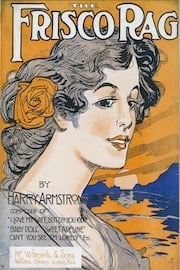
To evoke not just the sights but also the sounds of the PPIE, sound designer Andrew Roth fills the gallery with echoes of the past including a recording of a special song written for the fair in 1915 and other hit songs of the time, the sounds of streetcars and Model Ts from that era, and more.
The most Expo-specific song heard in the Conservatory is the "Panama-Pacific Expo March," composed by trombone soloist Al Pinard in 1914. Pinard is famous for playing with the Arthur Pryor band and as a composer of other best-selling band works, including "Thatsum Rag." "The Panama Pacific March" is by Harry Alford, a pioneering arranger with a catalog of 34,000 arrangements. "The Pathfinder of Panama March" was written and performed at the Expo by John Philip Sousa.
Reminiscent of James M. Keller's "Singing the Golden State" exhibit of sheet music and album covers, music at the Conservatory recalls the same era. Keller's show from his private collection at the Society of California Pioneers was made even more PPIE-specific in the Society's Popular Songs of the Panama-Pacific International Exposition.
"Garden Railway: 1915 Pan–Pacific" is open Tuesdays–Sundays, 10 a.m. to 4 p.m., and is included with admission to the Conservatory. Admission ranges from $2 for children to $6 for San Francisco residents and $8 for non-residents.
Merola Honors Racette
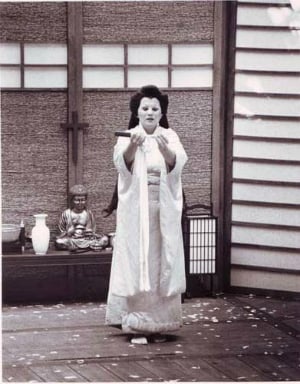
The San Francisco Merola Opera Program is awarding Patricia Racette the Merola Distinguished Alumni Award on Jan. 7. The event is by invitation only for members of Merola’s Gold Circle and above. (The soprano's less-affluent fans might be able to see and hear her around the same time at an S.F. Conservatory of Music master class; stay tuned to this column for details yet to be announced.)
The photo accompanying the announcement is from the memorable event at Villa Montalvo, where Racette stunned the audience as Cio-Cio-san in a spirited Madama Butterfly... 27 years ago, and yet I am sure others remember it just as fondly. Not even her greatest Butterfly in the War Memorial can erase the memory of the previous triumph while still in the training program.
Since her 1988 Merola year and the following three years as an Adler Fellow, Racette has gone on to conquer opera houses around the world, which is not an idle phrase. Besides her frequent appearances in the War Memorial, at the Met, and Santa Fe, Racette has performed in a wide variety of starring roles at Lyric Opera of Chicago, Houston Grand Opera, Washington National Opera, Los Angeles Opera, and internationally: the Royal Opera House, the English National Opera, Opéra National de Paris, Teatro alla Scala, Teatro Comunale di Bologna, Teatro Comunale di Firenze, Opera di Genova, Bayerische Staatsoper, Vienna Staatsoper, Teater an der Wien, Gran Teatre del Liceu in Barcelona, Opera Australia in Sydney, and the Saito Kinen Festival among others.
Racette has said of Merola: "It opened my world and changed my life, giving me the training, support, and opportunities that I appreciate and value to this day. There is no better training program."
For 58 years, the Merola Opera Program has been the cornerstone of San Francisco Opera's training and performance progression for promising young artists. Each summer, young artists from the United States and abroad are brought to San Francisco for 12 weeks of intensive studies and performance opportunities under the guidance of renowned teachers and performers. Besides Racette, star Merola alums include Joyce DiDonato, Susan Graham, Thomas Hampson, Leona Mitchell, Anna Netrebko, Rolando Villazón, Deborah Voigt, and Dolora Zajick.
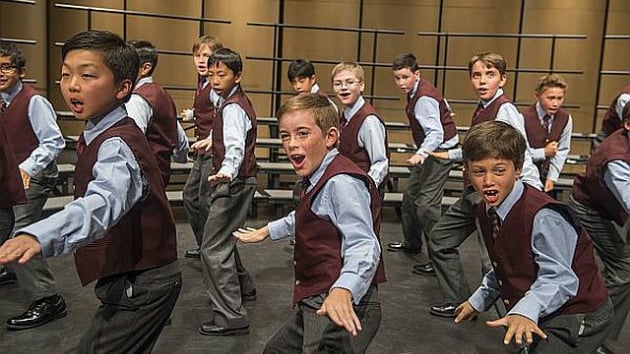
Ragazzi: 'Come and Play with Music'
Ragazzi Boys Chorus is recruiting new members with a low- (or no-) pressure, fun event: the annual SingFest!, on Jan. 16, in St. Peter’s Episcopal Church, Redwood City.
The event, running from 9:30 a.m. to 1 p.m., is an invitation "to play with music," as newcomers get to know the Ragazzi and what they do and have a chance to audition, but without any obligation to join the chorus. Before the event winds up, there is a brief concert presented to the visiting boys and their parents.
Ragazzi Artistic Director Joyce Keil says it's been her experience "that young people respond passionately to powerful music. For boys who join Ragazzi, musicianship and choral training provide life lessons in leadership, teamwork, excellence, and perseverance, and a deep appreciation of the power and beauty of music that transcends cultural differences."
Founded in 1987, Peninsula-based Ragazzi Boys Chorus now includes some 180 singers from 100 schools in 26 Bay Area communities. They perform with the San Francisco Opera, San Francisco Symphony, Opera San Jose, West Bay Opera, Lawrence Pech Dance Company, Peninsula Symphony, Masterworks Chorale, and the Stanford University Symphonic Chorus. Ragazzi groups have toured throughout the U.S. and internationally.
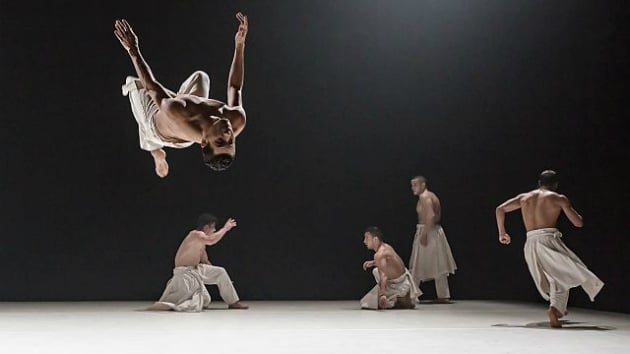
French-Algerian Dance Company in West Coast Debut
ODC Theater presents the West Coast debut of Compagnie Hervé KOUBI on Jan. 22-23 with What the Day Owes to the Night, the story based on Yasmina Khadra's novel. The French-Algerian company's presentation is a work of acrobatic dance for 12 men, combining elements of capoeira, martial arts, and urban and contemporary dance.
French choreographer Hervé Koubi founded the company in 2000, and his choreography reflects his own experience, "I would like to give life to my dreams as a child born in France, and who discovered belatedly his true origins and those of his parents, Algerians from birth."
The work has been more than three years in the making. Koubi traveled to Algeria to audition dancers, and the work premiered in France in 2013, with an ensemble of 11 Algerians and one dancer from Burkina Faso. Koubi has collaborated with Guillaume Gabriel on all of his works, and with musicians such as Laetitia Sheriff, contemporary authors like Chantal Thomas, filmmakers including Max Vadukul and Yoji Yamamoto, as well as a collective of dancers from the Ivory Coast.

